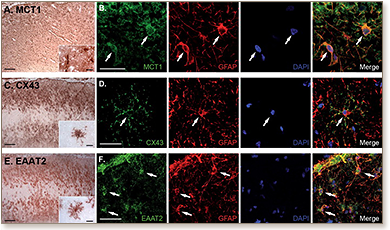 Emerging as an important correlate of neurological dysfunction in Multiple Sclerosis (MS), extended focal and diffuse gray matter abnormalities have been found and linked to clinical manifestations such as seizures, fatigue and cognitive dysfunction. To investigate possible underlying mechanisms we analyzed the molecular alterations in histopathological normal appearing cortical gray matter (NAGM) in MS. By performing a differential gene expression analysis of NAGM of control and MS cases we identified reduced transcription of astrocyte specific genes involved in the astrocyte-neuron lactate shuttle (ANLS) and the glutamate-glutamine cycle (GGC). Additional quantitative immunohistochemical analysis demonstrating a CX43 loss in MS NAGM confirmed a crucial involvement of astrocytes and emphasizes their importance in MS pathogenesis. Concurrently, a Toll-like/IL-1ß signaling expression signature was detected in MS NAGM, indicating that immune-related signaling might be responsible for the downregulation of ANLS and GGC gene expression in MS NAGM. Indeed, challenging astrocytes with immune stimuli such as IL-1ß and LPS reduced their ANLS and GGC gene expression in vitro. The detected upregulation of IL1B in MS NAGM suggests inflammasome priming. For this reason, astrocyte cultures were treated with ATP and ATP/LPS as for inflammasome activation. This treatment led to a reduction of ANLS and GGC gene expression in a comparable manner. To investigate potential sources for ANLS and GGC downregulation in MS NAGM, we first performed an adjuvant-driven stimulation of the peripheral immune system in C57Bl/6 mice in vivo. This led to similar gene expression changes in spinal cord demonstrating that peripheral immune signals might be one source for astrocytic gene expression changes in the brain. IL1B upregulation in MS NAGM itself points to a possible endogenous signaling process leading to ANLS and GGC downregulation. This is supported by our findings that, among others, MS NAGM astrocytes express inflammasome components and that astrocytes are capable to release Il-1ß in-vitro. Altogether, our data suggests that immune signaling of immune- and/or central nervous system origin drives alterations in astrocytic ANLS and GGC gene regulation in the MS NAGM. Such a mechanism might underlie cortical brain dysfunctions frequently encountered in MS patients.
Emerging as an important correlate of neurological dysfunction in Multiple Sclerosis (MS), extended focal and diffuse gray matter abnormalities have been found and linked to clinical manifestations such as seizures, fatigue and cognitive dysfunction. To investigate possible underlying mechanisms we analyzed the molecular alterations in histopathological normal appearing cortical gray matter (NAGM) in MS. By performing a differential gene expression analysis of NAGM of control and MS cases we identified reduced transcription of astrocyte specific genes involved in the astrocyte-neuron lactate shuttle (ANLS) and the glutamate-glutamine cycle (GGC). Additional quantitative immunohistochemical analysis demonstrating a CX43 loss in MS NAGM confirmed a crucial involvement of astrocytes and emphasizes their importance in MS pathogenesis. Concurrently, a Toll-like/IL-1ß signaling expression signature was detected in MS NAGM, indicating that immune-related signaling might be responsible for the downregulation of ANLS and GGC gene expression in MS NAGM. Indeed, challenging astrocytes with immune stimuli such as IL-1ß and LPS reduced their ANLS and GGC gene expression in vitro. The detected upregulation of IL1B in MS NAGM suggests inflammasome priming. For this reason, astrocyte cultures were treated with ATP and ATP/LPS as for inflammasome activation. This treatment led to a reduction of ANLS and GGC gene expression in a comparable manner. To investigate potential sources for ANLS and GGC downregulation in MS NAGM, we first performed an adjuvant-driven stimulation of the peripheral immune system in C57Bl/6 mice in vivo. This led to similar gene expression changes in spinal cord demonstrating that peripheral immune signals might be one source for astrocytic gene expression changes in the brain. IL1B upregulation in MS NAGM itself points to a possible endogenous signaling process leading to ANLS and GGC downregulation. This is supported by our findings that, among others, MS NAGM astrocytes express inflammasome components and that astrocytes are capable to release Il-1ß in-vitro. Altogether, our data suggests that immune signaling of immune- and/or central nervous system origin drives alterations in astrocytic ANLS and GGC gene regulation in the MS NAGM. Such a mechanism might underlie cortical brain dysfunctions frequently encountered in MS patients.